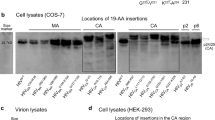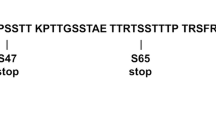Abstract
The human immunodeficiency virus type 1 Vpr is a virion-associated protein that is incorporated in trans into viral particles, presumably via an interaction with the p6 domain of the Gag polyprotein precursor. Recently, several studies demonstrated that Vpr fusion proteins could be used as intravirion inactivating agents. In this study, we compared different Vpr-chloramphenicol acetyltransferase (CAT) fusion proteins for their virion incorporation ability and their effect on the infectivity of HIV viruses. Our deletion analysis indicates that both the N-terminal alpha-helical domain and the leucine/isoleucine-rich (LR) domain located in the middle region of Vpr are required for optimal virion incorporation of Vpr-CAT fusion proteins. The C-terminal basic region, associated with Vpr’s ability to mediate cell cycle arrest in G2, was not required for virion incorporation, thus allowing the development of Vpr-based chimeric proteins devoid of any effect on cell growth. The fusion of Vpr at the N- or C-terminus of CAT targeted with equal efficiency the chimeric protein into virions. While the virion incorporation of most Vpr-CAT fusion proteins tested in this study was dependent on the presence of an intact p6 domain, fusion proteins containing only the N-terminal alpha-helical domain of Vpr (amino acid 1 to 42) were incorporated into virions in a p6-independent manner. Virion incorporation of Vpr-CAT fusion proteins was shown to decrease viral infectivity. Moreover, the insertion of HIV protease-cleavage sites between Vpr and CAT not only efficiently delivered and released the cleaved CAT product into HIV viral particles, but also greatly potentiated the inhibition of progeny virion infectivity. Overall, our study: (1) defines the Vpr sequence requirement and configuration necessary for the specific and optimal incorporation of Vpr fusion protein into HIV particles; (2) shows that Vpr fusion proteins have the ability to suppress HIV infectivity by targeting multiple steps of viral morphogenesis.
This is a preview of subscription content, access via your institution
Access options
Subscribe to this journal
Receive 12 print issues and online access
$259.00 per year
only $21.58 per issue
Buy this article
- Purchase on Springer Link
- Instant access to full article PDF
Prices may be subject to local taxes which are calculated during checkout






Similar content being viewed by others
References
Cohen EA, Dehni G, Sodroski JG, Haseltine WA . Human immunodeficiency virus Vpr product is a virion-associated regulatory protein J Virol 1990 64: 3097–3099
Yu X-F, Matsuda M, Essex M, Lee TH . Open reading frame Vpr of simian immunodeficiency virus encodes a virion-associated protein J Virol 1990 64: 5688–5693
Heinzinger NK et al. The Vpr protein of human immunodeficiency virus type 1 influences nuclear localization of viral nucleic acids in nondividing host cells Proc Natl Acad Sci USA 1994 91: 7311–7315
Levy DN, Fernandes LS, Williams WV, Weiner DB . Induction of cell differentiation by human immunodeficiency virus 1 Vpr Cell 1993 72: 541–550
Rogel ME, Wu LI, Emerman M . The human immunodeficiency virus type 1 Vpr gene prevents cell proliferation during chronic infection J Virol 1995 69: 882–888
He J et al. Human immunodeficiency virus type 1 viral protein R (Vpr) arrests cells in the G2 phase of the cell cycle by inhibiting p34cdc2 activity J Virol 1995 69: 6705–6711
Re F, Braaten D, Franke EK, Luban J . Human immunodeficiency virus type 1 Vpr arrests the cell cycle in G2 by inhibiting the activation of p34cdc2-cyclin B J Virol 1995 69: 6859–6864
Goh WC et al. HIV-1 Vpr increases viral expression by manipulation of the cell cycle: a mechanism for selection of Vpr in vivo Nature Med 1998 4: 65–71
Subbramanian RA et al. Human immunodeficiency virus type 1 is a positive regulator of viral transcription and infectivity in primary human macrophages J Exp Med 1998 187: 1103–1111
Yao X-J et al. Vpr stimulates viral expression and induces cell killing in human immunodeficiency virus type 1 infected dividing Jurkat T cells J Virol 1998 72: 4686–4693
Mahalingam S et al. Mutagenesis of the putative alpha-helical domain of the Vpr protein of human immunodeficiency virus type 1: effect on stability and virion incorporation Proc Natl Acad Sci USA 1995 92: 3794–3798
Yao X-J et al. Mutagenic analysis of human immunodeficiency virus type 1 Vpr: role of a predicted N-terminal alpha-helical structure in Vpr nuclear localization and virion incorporation J Virol 1995 69: 7032–7044
Paxton W, Connor RI, Landau NR . Incorporation of Vpr into human immunodeficiency virus type 1 virions: requirement for the p6 region of Gag and mutational analysis J Virol 1993 67: 7229–7237
Lu YL, Spearman P, Ratner L . Human immunodeficiency virus type 1 viral protein R localization in infected cells and virions J Virol 1993 67: 6542–6550
Lavallée C et al. Requirement of the Pr55gag precursor for incorporation of the Vpr product into human immunodeficiency type 1 viral particles J Virol 1994 68: 1926–1934
Kondo E, Mammano F, Cohen EA, Göttlinger HG . The p6gag domain of human immunodeficiency type 1 is sufficient for the incorporation of Vpr into heterologous viral particles J Virol 1995 69: 6304–6313
Checroune F et al. Incorporation of Vpr into human immunodeficiency virus type 1: role of conserved regions within the p6 domain of Pr55gag J AIDS Hum Retrovirol 1995 10: 1–7
Lu YL et al. A leucine triplet repeat sequence (LXX)4 in p6gag is important for Vpr incorporation into human immunodeficiency virus type 1 particles J Virol 1995 69: 6873–6879
Kondo E, Göttlinger HG . A conserved LXXLF sequence is the major determinant in p6gag required for the incorporation of human immunodeficiency virus type 1 Vpr J Virol 1996 70: 159–164
Li M-S et al. The Vpr protein of human immunodeficiency virus type 1 binds to nucleocapsid protein p7 in vitro Biochem Biophy Res Commun 1996 218: 352–355
de Rocquigny H et al. The zinc fingers of HIV nucleocapsid protein NCp7 direct interaction with the viral regulatory protein Vpr J Biol Chem 1997 273: 30753–30759
Wu X-Y et al. Functional RT and IN incorporated into HIV-1 particles independently of the Gag/Pol precursor protein EMBO J 1997 16: 5113–5122
Fletcher TM et al. Complementation of integrase function in HIV-1 virions EMBO J 1997 16: 5123–5138
Sato A et al. Targeting of chloramphenicol acetyltransferase to human immunodeficiency virus particles via Vpr and Vpx Microbiol Immunol 1995 39: 1015–1019
Park I-W, Sodroski J . Targeting a foreign protein into virion particles by fusion with the Vpx protein of simian immunodeficiency virus J AIDS Hum Retrovirol 1995 11: 341–350
Wu X-Y et al. Targeting foreign proteins to human immunodeficiency virus particles via fusion with Vpr and Vpx J Virol 1995 69: 3389–3398
Wu X-Y et al. Inhibition of human and simian immunodeficiency virus type protease function by targeting Vpx-protease-mutant fusion protein into viral particles J Virol 1996 70: 3378–3384
Kobinger GP et al. Virion-targeted viral inactivation against the human immunodeficiency type 1 using Vpr fusion proteins J Virol 1998 72: 5441–5448
Zhao LJ, Mukherjee S, Narayan O . Biochemical mechanism of HIV-1 Vpr function: specific interaction with a cellular protein J Biol Chem 1994 269: 15577–15582
Di Marzio P et al. Mutational analysis of cell cycle arrest, nuclear localization and virion packaging of human immunodeficiency virus type 1 Vpr J Virol 1995 69: 7909–7916
Mahalingam S et al. Nuclear import, virion incorporation, and cell cycle arrest/differentiation are mediated by distinct functional domains of human immunodeficiency virus type 1 Vpr J Virol 1997 71: 6339–6347
Göttlinger HG, Dorfman T, Sodroski JG, Haseltine WA . Effect of mutations affecting the p6 gag protein on human immunodeficiency virus particle release Proc Natl Acad Sci USA 1991 88: 3195–3199
Darke PL et al. HIV-1 protease specificity of peptide cleavage is sufficient for processing of gag and pol polyproteins Biochem Biophys Res Commun 1988 156: 297–303
Göttlinger HG, Sodroski JG, Haseltine WA . Role of capsid precursor processing and myristoylation in morphogenesis and infectivity of Human immunodeficiency virus type 1 Proc Natl Acad Sci USA 1989 86: 5781–5785
Kimpton J, Emerman M . Detection of replication-competent and pseudotyped human immunodeficiency virus with a sensitive cell line on the basis of activation of an integrated β-galactosidase gene J Virol 1992 66: 2232–2239
Cohen EA et al. Identification of HIV-1 Vpr product and function J Acquir Immun Def Synd 1990 1: 11–18
Serio D et al. Development of a novel anti-HIV-1 agent from within: effect of chimeric Vpr-containing protease cleavage site residues on virus replication Proc Natl Acad Sci USA 1997 94: 3346–3351
Coffin JM, Hughes SH, Varmus HE . Retroviruses Cold Spring Harbor Laboratory Press: Cold Spring Harbor 1997 pp 27–69
Henderson LE et al. Isolation and characterization of a novel protein (x-orf product) from SIV and HIV-2 Science 1988 241: 199–201
Matsuda Z et al. A virion-specific inhibitory molecule with therapeutic potential for human immunodeficiency virus type 1 Proc Natl Acad Sci USA 1993 90: 3544–3548
Lee MH, Sano K, Morales FE, Imagawa DT . Sensitive reverse transcriptase assay to detect and quantitate human immunodeficiency virus J Clin Microbiol 1987 25: 1717–1721
Acknowledgements
We would like to thank Drs Dominique Bergeron, Andrew J Mouland and Ramu A Subbramanian for helpful discussions. We thank Dr Göttlinger for supplying plasmids SVC-p2 and HxBc2/p6−(S17/s). We also thank Dr Michael Emerman for providing HeLa-CD4-β-Gal cell line, that was obtained through the AIDS Research and Reference Reagent Program, Division of AIDS, NIAID, NIH. GP Kobinger is a recipient of a studentship from the National Health Research and Development Program (NHRDP) of Canada. S Dandache is a recipient of a studentship from the Natural Sciences and Engineering Research Council of Canada (NSERC) and Theratechnologies Inc. EA Cohen is a recipient of a Medical Research Council Scientist award. This work was supported by grants from MRC, Theratechnologies Inc and FCAR to EA Cohen.
Author information
Authors and Affiliations
Rights and permissions
About this article
Cite this article
Yao, XJ., Kobinger, G., Dandache, S. et al. HIV-1 Vpr-chloramphenicol acetyltransferase fusion proteins: sequence requirement for virion incorporation and analysis of antiviral effect. Gene Ther 6, 1590–1599 (1999). https://doi.org/10.1038/sj.gt.3300988
Received:
Accepted:
Published:
Issue Date:
DOI: https://doi.org/10.1038/sj.gt.3300988
Keywords
This article is cited by
-
Reducing IRF-1 to Levels Observed in HESN Subjects Limits HIV Replication, But Not the Extent of Host Immune Activation
Molecular Therapy - Nucleic Acids (2015)
-
HIV-1 Accessory Protein Vpr: Relevance in the pathogenesis of HIV and potential for therapeutic intervention
Retrovirology (2011)
-
Site-specific Gene Insertion Mediated by a Cre-loxP-carrying Lentiviral Vector
Molecular Therapy (2010)
-
Contribution of the C-terminal region within the catalytic core domain of HIV-1 integrase to yeast lethality, chromatin binding and viral replication
Retrovirology (2008)
-
The Vpr protein from HIV-1: distinct roles along the viral life cycle
Retrovirology (2005)



